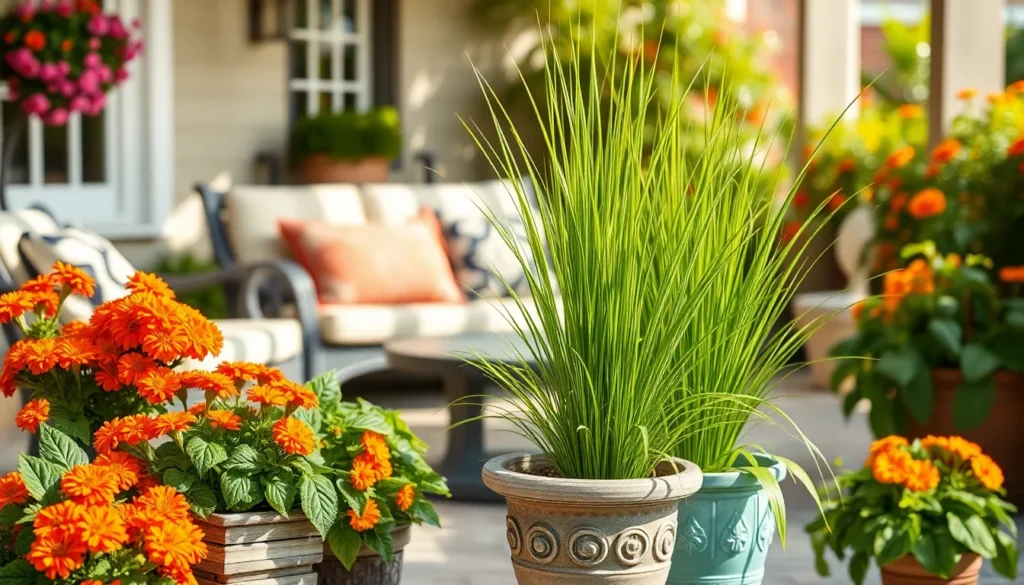We’ve all been there – trying to enjoy a peaceful evening on our patio only to become a buffet for hungry mosquitoes. While chemical repellents work, they’re not always the solution we want around our family and pets. That’s where container gardening with mosquito-repelling plants becomes a game-changer for outdoor living.
Growing these natural pest deterrents in containers offers us incredible flexibility and effectiveness. We can strategically place them exactly where we need protection most – near seating areas, doorways, or anywhere mosquitoes tend to gather. Plus, container gardening means we’re not limited by soil conditions or permanent landscaping decisions.
The best part? Many of these plants don’t just repel mosquitoes – they’ll also beautify our outdoor spaces with gorgeous blooms and delightful fragrances. From aromatic herbs to stunning flowering plants, we’ll discover how the right container setup can create a natural barrier that keeps those pesky insects at bay while improving our outdoor experience.
Choose the Right Container Size for Your Mosquito Repelling Plants
Getting the container size right makes all the difference in how well your mosquito repelling plants thrive and protect your outdoor space. We’ve found that proper sizing directly impacts plant health, growth potential, and eventually their effectiveness at keeping mosquitoes away.
Consider Root Space Requirements
Root space determines how well your mosquito repelling plants can establish themselves and produce the oils that naturally deter insects. Most aromatic herbs like basil, rosemary, and lavender need containers that are at least 12 inches deep to develop strong root systems. These plants invest important energy in their roots, which directly correlates to their ability to produce potent essential oils.
We recommend measuring root space by both depth and width when selecting containers. Citronella grass requires containers at least 18 inches wide and 14 inches deep because of its spreading growth habit. Marigolds can thrive in smaller 8 inch containers, while lemon balm needs 12 inch wide pots to accommodate its vigorous spreading nature.
Plants with insufficient root space become stressed and produce fewer of the natural compounds that repel mosquitoes. Container bound plants also require more frequent watering and fertilizing, making maintenance more demanding. We’ve observed that properly sized containers result in healthier plants that emit stronger fragrances throughout the growing season.
Select Proper Drainage Features
Drainage holes prevent waterlogged soil that mosquitoes love for breeding while keeping your repelling plants healthy. We always choose containers with multiple drainage holes rather than single large openings. Small holes every 2 to 3 inches around the bottom provide better water distribution and prevent soil from washing out.
Elevated containers with built in drainage trays work exceptionally well for mosquito repelling plants. These systems allow excess water to drain away while preventing standing water that attracts the very pests we’re trying to repel. We place a layer of gravel or broken pottery in the bottom of containers to improve drainage further.
Consider containers with side drainage holes if you live in areas with heavy rainfall. Plants like rosemary and lavender are particularly sensitive to wet feet and benefit from enhanced drainage systems. We’ve found that proper drainage reduces plant disease and maintains the soil conditions these aromatic plants need to produce their mosquito deterring properties.
Match Container Size to Plant Growth
Mature plant size should guide your container selection to ensure your mosquito repelling garden remains effective and attractive. We start with the expected full size of each plant and work backward to determine appropriate container dimensions. A lavender bush that reaches 24 inches wide needs a container at least 18 inches in diameter to look proportional and have room to spread.
Here’s our recommended container sizing guide for popular mosquito repelling plants:
| Plant Type | Container Width | Container Depth | Mature Size |
|---|---|---|---|
| Basil | 8-10 inches | 8 inches | 12-18 inches tall |
| Citronella Grass | 18-24 inches | 14 inches | 24-36 inches wide |
| Lavender | 16-18 inches | 12 inches | 24 inches wide |
| Marigolds | 6-8 inches | 6 inches | 8-12 inches tall |
| Rosemary | 14-16 inches | 12 inches | 24-36 inches tall |
| Lemon Balm | 12-14 inches | 10 inches | 18-24 inches wide |
We plan for containers that accommodate 2 to 3 years of growth to avoid frequent repotting. Plants that outgrow their containers become root bound and lose their vigor, reducing their mosquito repelling effectiveness. Strategic container sizing also allows us to create attractive groupings that provide maximum coverage for outdoor entertaining areas.
Select the Best Mosquito Repelling Plants for Container Growing
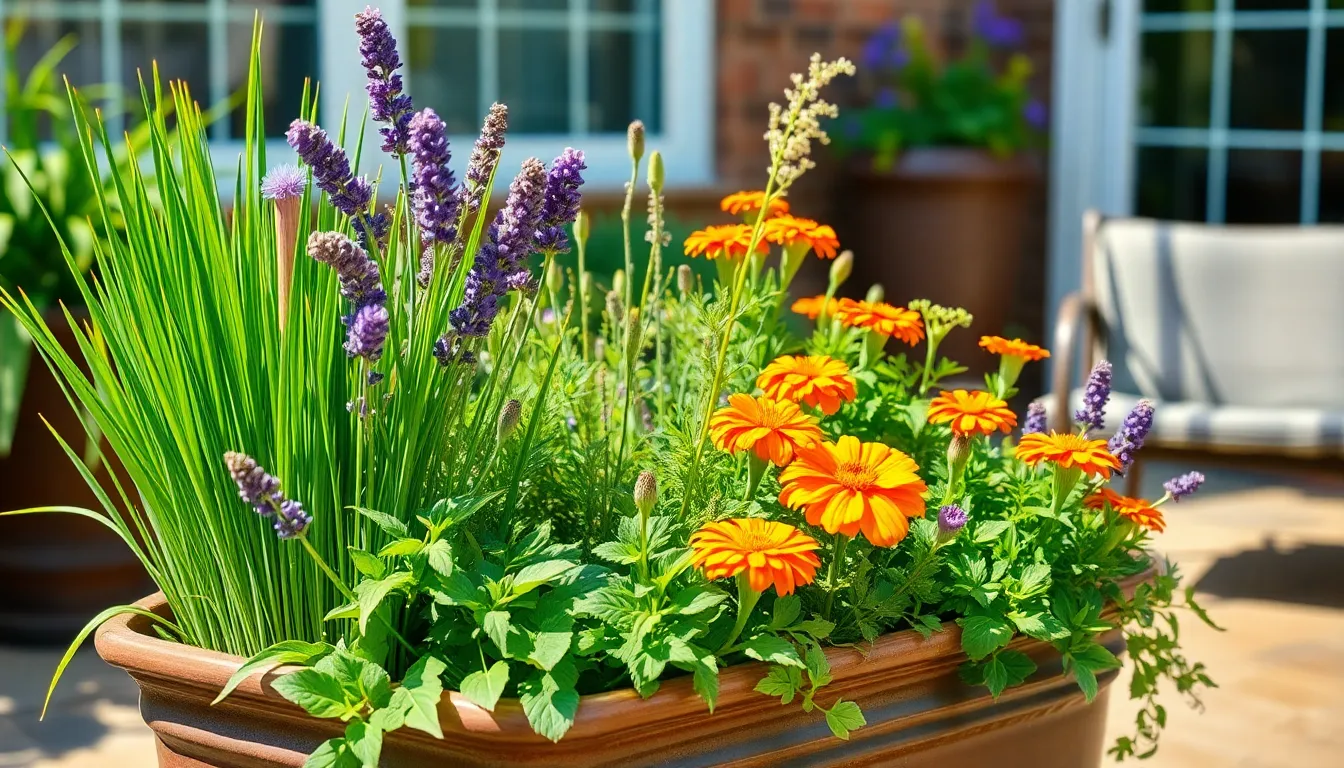
Choosing effective mosquito repelling plants requires understanding which varieties thrive in containers while providing maximum natural protection.
Citronella Grass for Natural Protection
Citronella grass stands as the most widely recognized natural mosquito repellent we can grow in containers. The plant emits a powerful lemony scent that masks human odors and confuses mosquitoes, keeping them away from our outdoor spaces more effectively than citronella oil alone.
We recommend growing citronella grass in large containers since it needs ample root space to thrive. This low maintenance plant flourishes in sunny locations and works best in warmer climates within zones 9-11, as it cannot tolerate frost conditions.
Container growing allows us to move citronella grass indoors during colder months, extending its protective benefits year round. The living plant continuously releases its mosquito deterring compounds, making it superior to processed alternatives.
Lavender for Fragrant Defense
Lavender provides dual benefits as both a mosquito repellent and aromatic enhancement to our container gardens. Its strong fragrance creates an unpleasant environment for mosquitoes while offering us calming scents that improve our outdoor experience.
Growing Lavandula angustifolia in containers requires well drained soil and ample sunlight for optimal performance. We can maintain compact lavender plants that flower multiple times annually with regular pruning, maximizing both their beauty and protective properties.
Container grown lavender adapts well to various outdoor spaces, from patios to balconies. The plant’s natural oils become more concentrated when grown in containers, intensifying its mosquito repelling effectiveness.
Marigolds for Colorful Deterrence
Marigolds offer vibrant color while naturally repelling mosquitoes through compounds found in their flower petals. These decorative plants provide functional pest control alongside bright visual appeal, making them perfect additions to our container mosquito defense strategy.
We should select compact marigold varieties like Calendula ‘Bon Bon Bright Yellow’ for optimal container performance. These plants thrive in sunny spots and effectively deter mosquitoes, whiteflies, and aphids from our outdoor areas.
Container grown marigolds require minimal maintenance while delivering consistent mosquito protection throughout their blooming season. Their pest deterring properties extend beyond mosquitoes, creating comprehensive natural protection for our outdoor spaces.
Catnip for Powerful Repelling Action
Catnip delivers the most potent mosquito repelling action among container friendly plants, with studies showing effectiveness exceeding DEET in some cases. The plant’s pungent scent creates a highly offensive environment for mosquitoes, providing superior natural protection.
We can grow catnip successfully in containers with full sun to partial shade conditions, making it versatile for various patio and deck arrangements. This adaptable plant tolerates different light conditions while maintaining its powerful mosquito deterring properties.
Container cultivation allows us to control catnip’s spread while maximizing its protective benefits in targeted areas. The plant’s robust nature ensures consistent mosquito repelling performance throughout the growing season with minimal care requirements.
Prepare Your Container with Proper Soil and Drainage
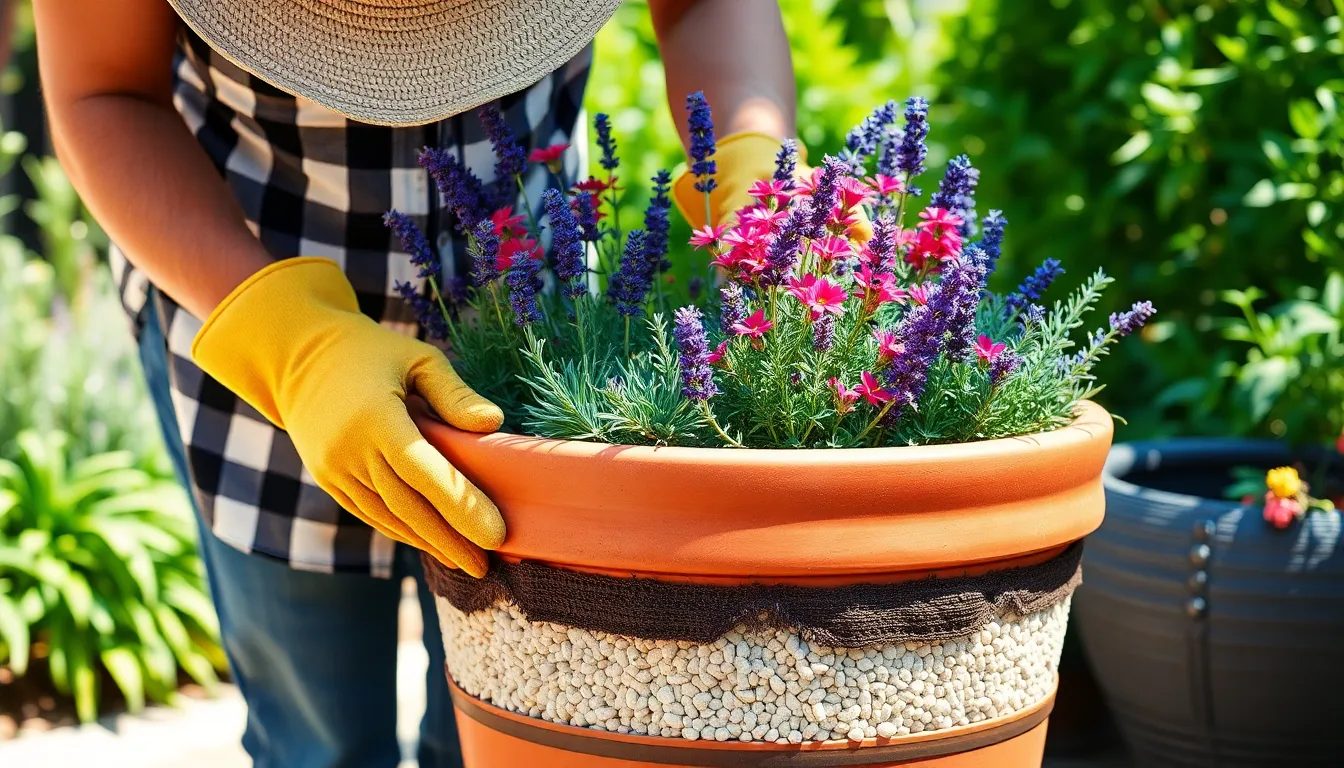
Creating an effective mosquito-repelling container garden requires more than just selecting the right plants. We need to establish the proper foundation that’ll support healthy plant growth and maximize their insect-deterring properties.
Use Well-Draining Potting Mix
Quality potting mix forms the foundation of any successful container garden. We recommend selecting a high-quality potting mix specifically designed for container plants rather than using garden soil, which becomes too heavy and compacts easily in pots. Well-draining soil prevents waterlogging that can harm plant roots and reduce the effectiveness of mosquito-repelling compounds.
Premium potting mixes typically contain perlite, vermiculite, or coconut coir that promote proper drainage while retaining essential nutrients. These ingredients create air pockets that allow roots to breathe and prevent the soggy conditions that weaken plants like lavender, rosemary, and marigolds. Strong, healthy plants produce more potent essential oils and fragrances that effectively repel mosquitoes.
Add Drainage Layers at the Bottom
Drainage layers create an essential barrier between your potting mix and the container bottom. We place a 1-2 inch layer of gravel, small stones, or broken pottery shards at the base of each container to enhance water flow and prevent soil compaction.
These materials allow excess water to collect below the soil level instead of saturating the root zone of our mosquito-repelling plants. Proper drainage layers ensure that herbs like basil, sage, and lemongrass don’t develop root rot, which would compromise their ability to produce the aromatic compounds that naturally deter insects.
Ensure Adequate Drainage Holes
Multiple drainage holes throughout the container bottom guarantee that excess water escapes freely. We make sure our containers have several drainage holes rather than just one large opening, as this creates more consistent water flow across the entire base.
Containers without sufficient drainage create waterlogged conditions that attract mosquitoes rather than repel them, defeating our garden’s purpose. Most mosquito-repelling plants like lavender and rosemary require well-drained soil and 6-8 hours of daily sunlight to thrive and release their effective scents. Proper drainage holes maintain ideal soil moisture levels that support healthy plant growth and maximize their natural pest-deterring properties.
Position Your Mosquito Repelling Plant Containers Strategically
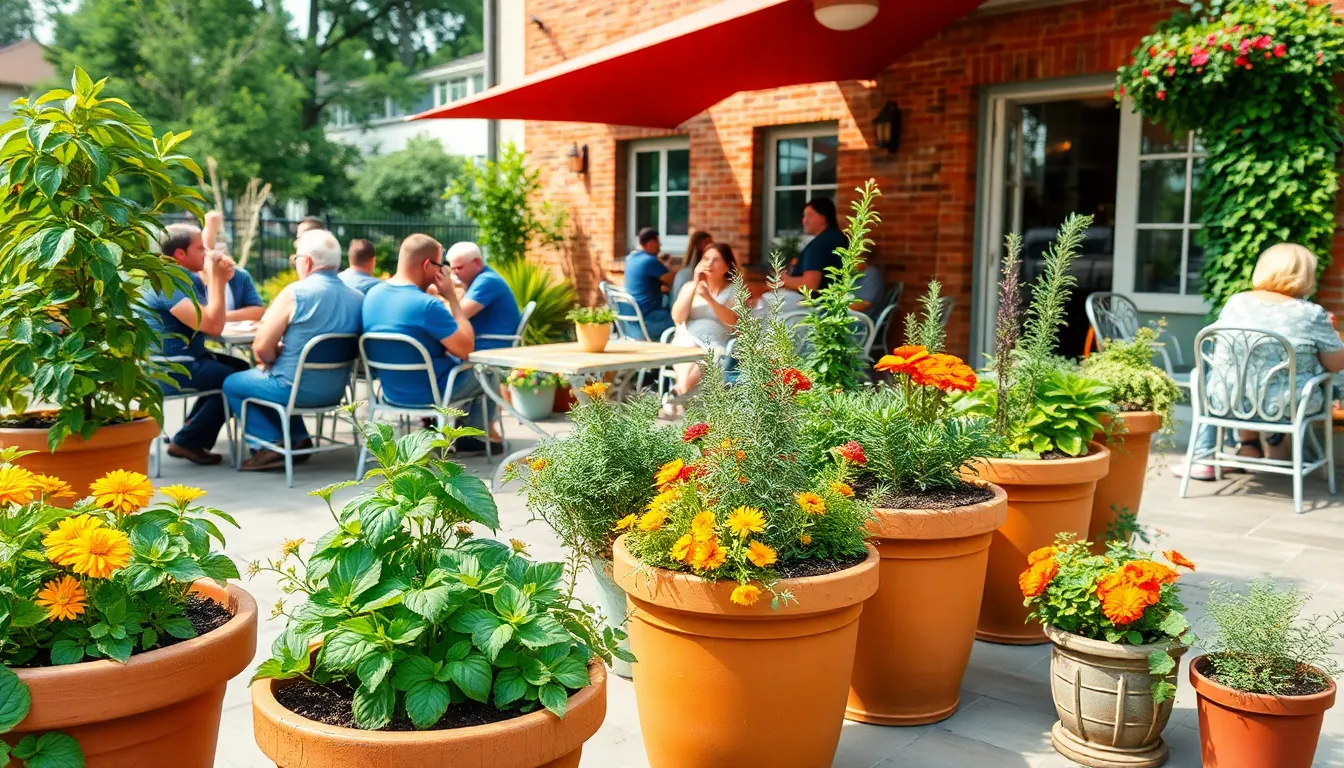
Strategic placement transforms your mosquito repelling plants from decorative elements into powerful natural deterrents. We’ll show you how to position these containers for maximum effectiveness around your outdoor spaces.
Place Near Outdoor Seating Areas
Positioning containers close to where people gather creates the most effective mosquito protection. We recommend placing your basil, marigolds, and scented geraniums within 3-5 feet of patios, decks, or outdoor seating areas where the plants’ natural scents can form a protective barrier.
Concentrating these aromatic plants near high-traffic zones ensures their mosquito-repelling compounds reach the areas where you need protection most. Strategic placement around seating areas allows the plants’ essential oils to create an invisible shield that mosquitoes actively avoid.
Brushing against these plants while moving around your outdoor space transfers their protective scents to your clothing and skin. This natural contact method provides an additional layer of mosquito deterrence beyond the plants’ ambient fragrance.
Position Around Entry Points
Doorways and windows serve as primary mosquito entry routes into your outdoor living spaces. We suggest placing containers filled with sage, oregano, and trailing oregano near these access points to create your first line of defense against mosquito intrusions.
Blocking these common entry points with strategically placed containers prevents mosquitoes from reaching your seating areas in the first place. Multiple containers positioned around doorways and windows amplify the deterrent effect by concentrating the plants’ natural repelling compounds.
Entry point placement works particularly well with Thai basil and Red Rubin basil varieties, which not only repel adult mosquitoes but also deter them from laying eggs in nearby water sources. This dual action approach reduces both immediate mosquito presence and future population growth around your outdoor spaces.
Create Barrier Gardens on Patios
Arranging multiple containers in strategic formations around your patio creates concentrated zones of mosquito-repelling protection. We recommend using 4-6 containers spaced 2-3 feet apart to form an effective barrier that mosquitoes won’t cross.
Barrier gardens work by concentrating the combined scents of rosemary, tri-color sage, and marigolds into a powerful deterrent wall. This concentrated approach enhances each plant’s individual mosquito-repelling properties while creating visual appeal through varied heights and textures.
Mobile container arrangements allow you to adjust your barrier garden based on seasonal needs and changing outdoor activity patterns. Moving containers to different positions throughout the summer maximizes protection while ensuring your plants receive optimal sunlight for continued vigor and effectiveness.
Maintain Your Container Mosquito Repelling Plants Effectively
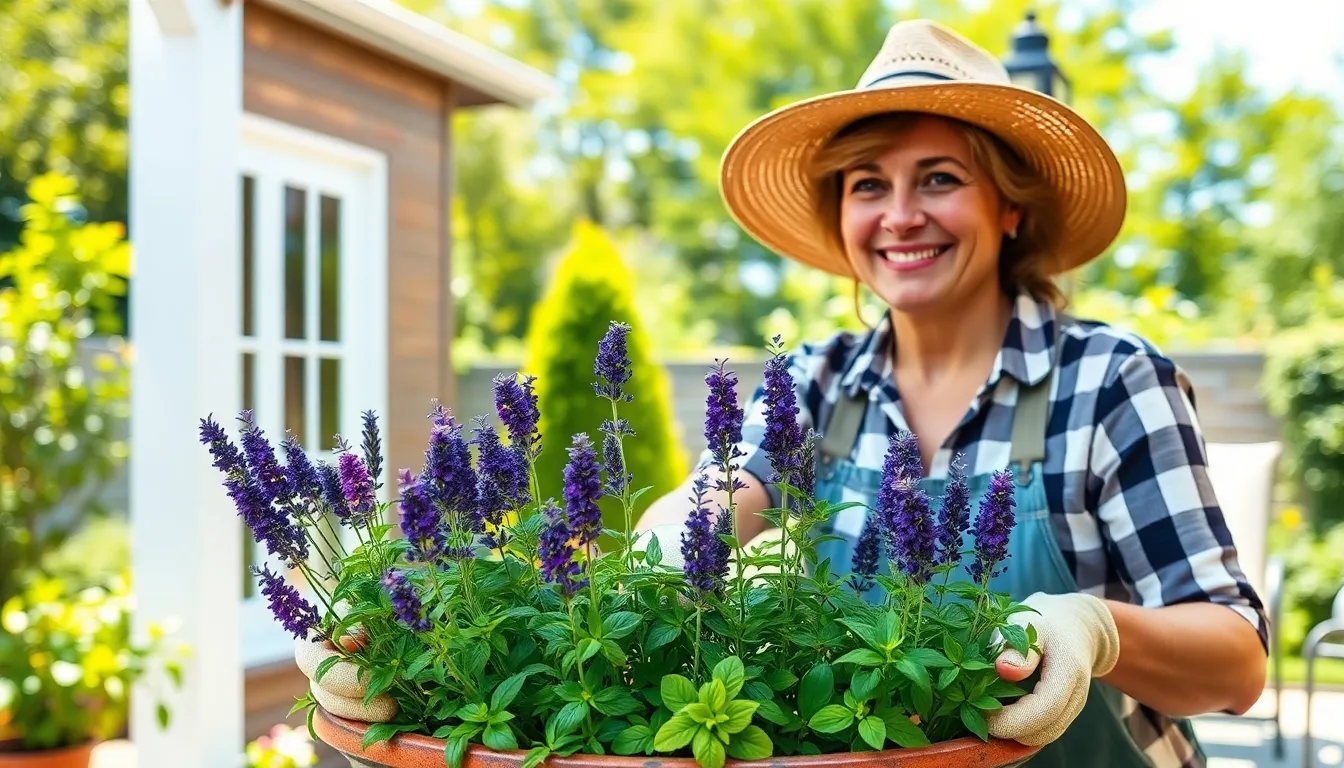
Proper maintenance ensures your mosquito repelling plants remain healthy and produce the essential oils that keep mosquitoes at bay. We’ll help you master the key practices that maximize both plant health and their natural pest deterrent properties.
Water According to Plant Needs
Avoid overwatering to prevent stagnant water conditions that actually attract mosquitoes to your containers. Most aromatic herbs like rosemary, lavender, and basil prefer well drained soil with moderate watering schedules rather than constantly moist conditions.
Check soil moisture by inserting your finger 1-2 inches deep into the potting mix before watering. Water thoroughly when the top inch feels dry, allowing excess water to drain completely from the container’s drainage holes.
Establish consistent watering routines based on each plant’s exact requirements and seasonal changes. Citronella grass needs more frequent watering during hot summer months, while lavender thrives with less frequent but deeper watering sessions.
Remove standing water from saucers and trays within 30 minutes after watering to eliminate potential mosquito breeding sites. Empty containers store water that becomes a mosquito magnet, defeating the purpose of growing these repellent plants.
Prune Regularly for Maximum Oils
Encourage new growth through regular pruning, which increases the production of essential oils that actually repel mosquitoes. Fresh growth on plants like lavender and rosemary contains higher concentrations of the aromatic compounds mosquitoes find offensive.
Pinch flower buds on herbs like basil and oregano to redirect the plant’s energy into producing more fragrant foliage rather than seeds. This practice keeps the plants bushy and maintains their mosquito repelling potency throughout the growing season.
Harvest frequently by cutting stems and leaves for culinary use, which serves as natural pruning for herbs like Thai basil and sage. Regular harvesting stimulates continuous growth and ensures your plants maintain their peak aromatic strength.
Deadhead spent flowers on marigolds and other flowering mosquito repellent plants to promote continued blooming and maintain their pest deterring compounds. This practice also keeps your container garden looking attractive while maximizing its functional benefits.
Fertilize for Healthy Growth
Use balanced fertilizers appropriate to each plant species to support vigorous, healthy growth that sustains their fragrance and repellent qualities. Strong, well fed plants produce more of the essential oils that create effective mosquito barriers around your outdoor spaces.
Apply liquid fertilizer every 2-3 weeks during the growing season for fast growing herbs like lemon balm and pineapple mint. Container plants need more frequent feeding than ground planted ones since nutrients wash out through drainage holes with regular watering.
Choose organic options like fish emulsion or compost tea to nourish your mosquito repelling plants without introducing harsh chemicals near your living spaces. Natural fertilizers support beneficial soil microorganisms that enhance plant health and oil production.
Monitor plant response by observing leaf color, growth rate, and overall vigor to adjust fertilizing schedules as needed. Healthy plants with rich green foliage and robust growth patterns produce the strongest natural mosquito deterrent effects in your container garden.
Maximize Mosquito Protection Through Plant Combinations
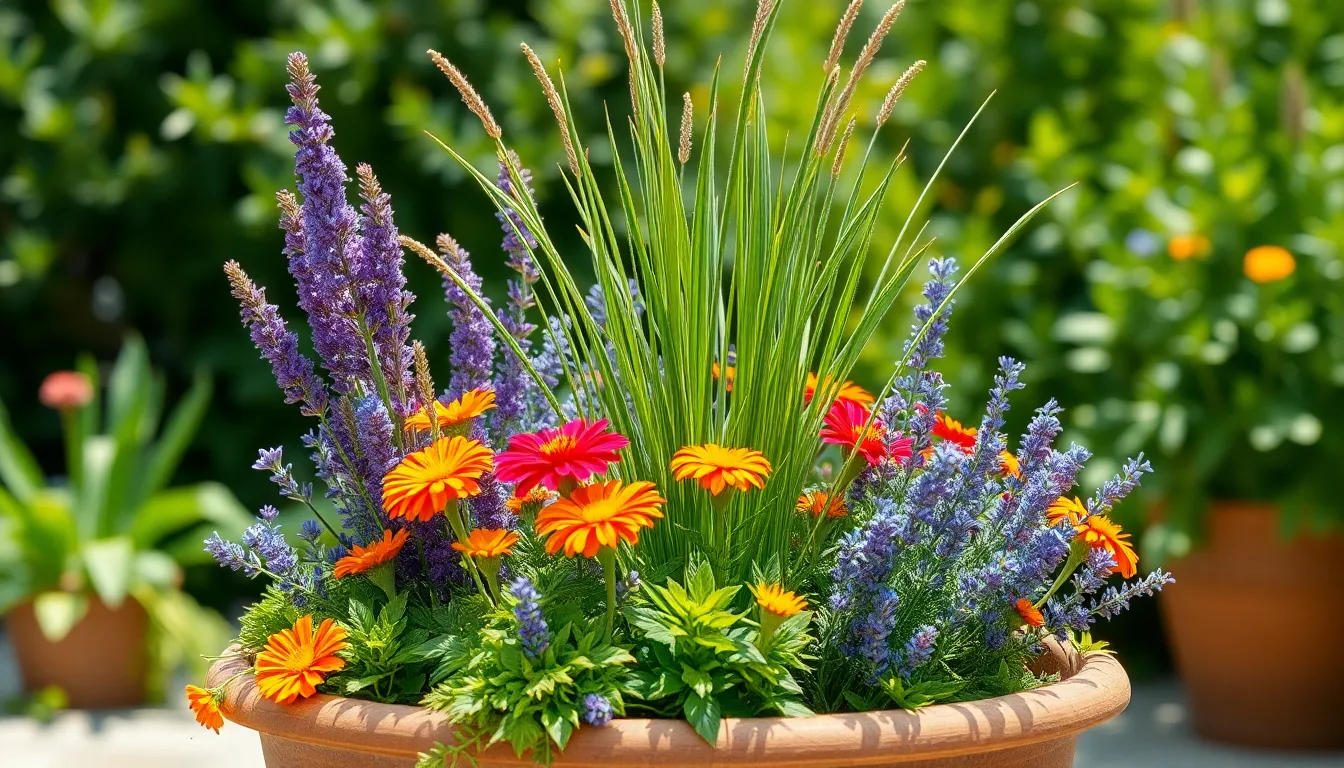
We can significantly boost our mosquito defense by strategically combining plants that work together to create stronger protective zones. Research shows that mixing different repellent plants amplifies their individual effects and extends coverage duration.
Pair Complementary Repelling Plants
Combining lemongrass and rosemary in the same container creates a powerful mosquito deterrent that lasts longer than either plant alone. Studies demonstrate that lemongrass provides up to 40 minutes of protection while rosemary offers around 15 minutes, and together they create overlapping scent profiles that confuse and repel mosquitoes more effectively.
Pairing marigolds with lavender produces complementary visual and aromatic benefits that enhance our outdoor spaces. These combinations work because different plants release various volatile oils that target mosquitoes through multiple sensory pathways, making it harder for them to adapt or find gaps in our natural barrier.
Mixing mint varieties like pineapple mint with other aromatic herbs creates diverse scent layers that mosquitoes find overwhelming. We’ve found that planting these combinations in larger containers allows their root systems to intertwine, creating healthier plants that produce stronger essential oil concentrations.
Layer Different Heights for Coverage
Creating multi level plant arrangements maximizes our mosquito protection by filling vertical space with repellent scents. Placing taller plants like lemongrass or rosemary in the center or back of containers while positioning shorter varieties like marigolds and compact lavender around the edges creates comprehensive coverage that mosquitoes can’t easily navigate around.
Layering different heights improves scent diffusion patterns by allowing aromatic compounds to distribute at various air levels. Research indicates that this vertical approach creates more effective barriers because mosquitoes fly at different heights depending on wind conditions and obstacles.
Using varieties like Calendula ‘Bon Bon Bright Yellow’ that grow about 12 inches tall provides perfect mid level coverage between ground level plants and taller specimens. We can enhance this layering effect by selecting compact lavender varieties such as Lavandula angustifolia ‘Thumbelina Leigh’ that bloom multiple times per year with proper care.
Create Scented Barriers
Crushing the leaves of our container grown herbs releases concentrated essential oils that create immediate personal protection zones. This technique works exceptionally well when we apply the crushed plant material directly to our skin while sitting near the potted plants, creating both contact and airborne barriers that mosquitoes actively avoid.
Positioning our container combinations near seating areas and doorways establishes concentrated scented zones that act as natural mosquito checkpoints. We can strengthen these barriers by gently brushing against the plants as we move through outdoor spaces, which releases fresh bursts of repellent compounds into the air.
Regularly harvesting and pruning our mosquito repelling plants stimulates new growth while maintaining strong scent emission levels. This practice ensures our scented barriers remain effective throughout the growing season because fresh plant material produces the highest concentrations of mosquito deterring essential oils.
Seasonal Care Tips for Container Mosquito Repelling Plants
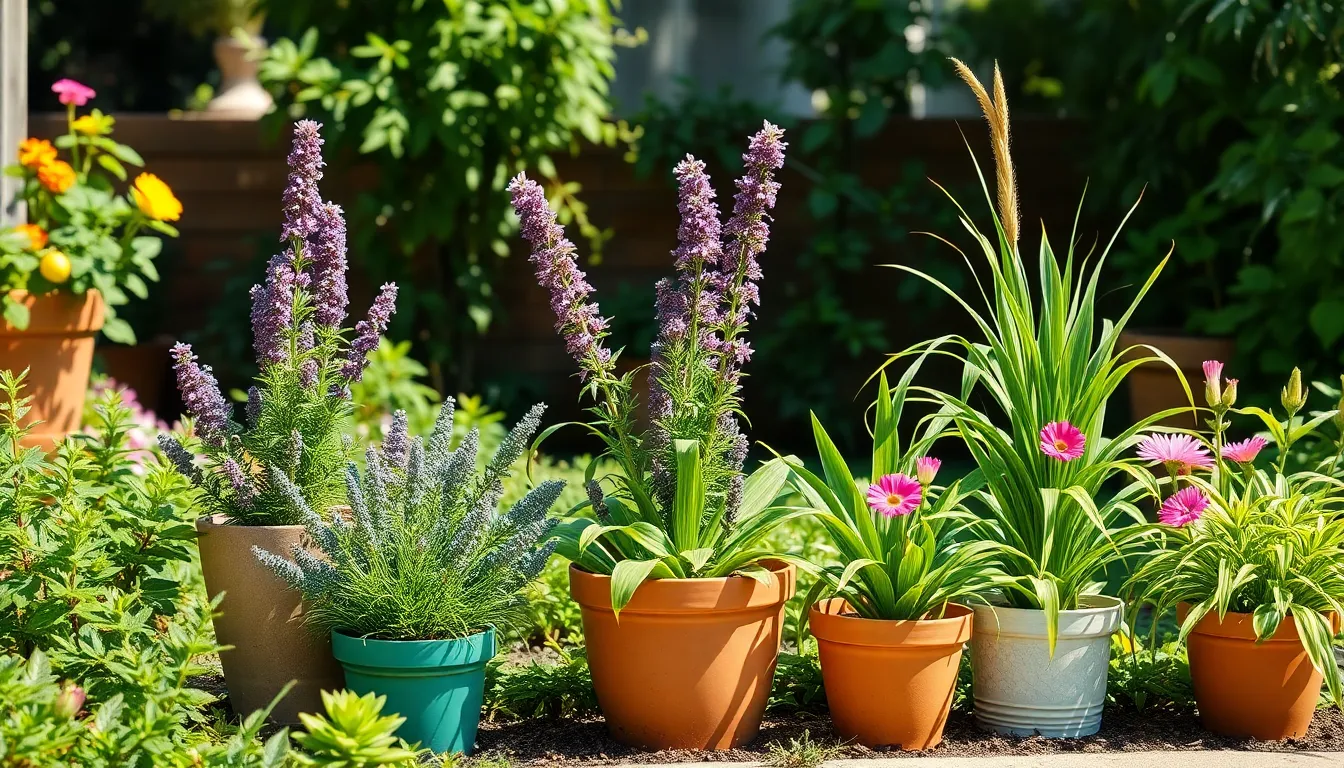
Proper seasonal care ensures our mosquito repelling container plants maintain their pest deterring properties throughout the growing season. Timing our care practices correctly maximizes plant health and extends their protective benefits year round.
Spring Planting and Setup
Plant citronella and frost sensitive varieties after the last frost when soil and air temperatures consistently warm to tomato planting conditions. Wait until nighttime temperatures stay above 50°F to prevent transplant shock and establish strong root systems.
Select containers with excellent drainage features and fill them with well draining potting mix enriched with aged compost or organic matter. Use containers at least 12 inches deep for aromatic herbs and ensure multiple drainage holes prevent waterlogged conditions that attract mosquitoes.
Position containers in locations receiving 6 to 8 hours of direct sunlight daily for optimal essential oil production in plants like lavender and lemongrass. Place larger containers in their permanent locations before filling to avoid moving heavy pots later.
Space plants adequately within containers to allow proper airflow and prevent overcrowding that reduces their mosquito repelling effectiveness. Follow mature size guidelines when arranging multiple plants in single large containers.
Summer Maintenance and Watering
Water deeply when the top inch of soil feels dry to maintain consistent moisture levels without creating stagnant conditions. Check soil moisture daily during hot weather as container plants dry out faster than ground planted varieties.
Feed plants every 2 to 3 weeks with water soluble fertilizer to promote continuous blooming and robust foliage growth in citronella and lavender varieties. Avoid over fertilizing which can reduce essential oil concentration in aromatic plants.
Prune flowering plants like lavender regularly to encourage repeated blooming cycles and maintain compact growth throughout the season. Pinch back spent flowers and trim leggy growth to keep plants productive and attractive.
Rotate container positions weekly to ensure even sun exposure and prevent plants from leaning toward light sources. Move containers to shadier spots during extreme heat waves above 90°F to prevent stress.
Fall Preparation and Storage
Reduce watering frequency as temperatures drop and stop fertilizing 6 to 8 weeks before expected frost to help plants prepare for dormancy. Allow soil to dry slightly between waterings to prevent root rot in cooler conditions.
Move frost sensitive plants like citronella and lemongrass indoors or to protected areas when nighttime temperatures approach 40°F. Choose bright indoor locations near south facing windows for overwintering success.
Cut back perennial plants such as lavender and mint after their final bloom cycle ends to maintain shape and promote healthy spring growth. Remove dead or damaged foliage to prevent pest and disease issues during dormancy.
Insulate hardy container plants that will remain outdoors by wrapping pots with burlap or moving them to sheltered locations against building walls. Group containers together to create microclimates that protect root systems from freezing.
Troubleshoot Common Container Growing Issues
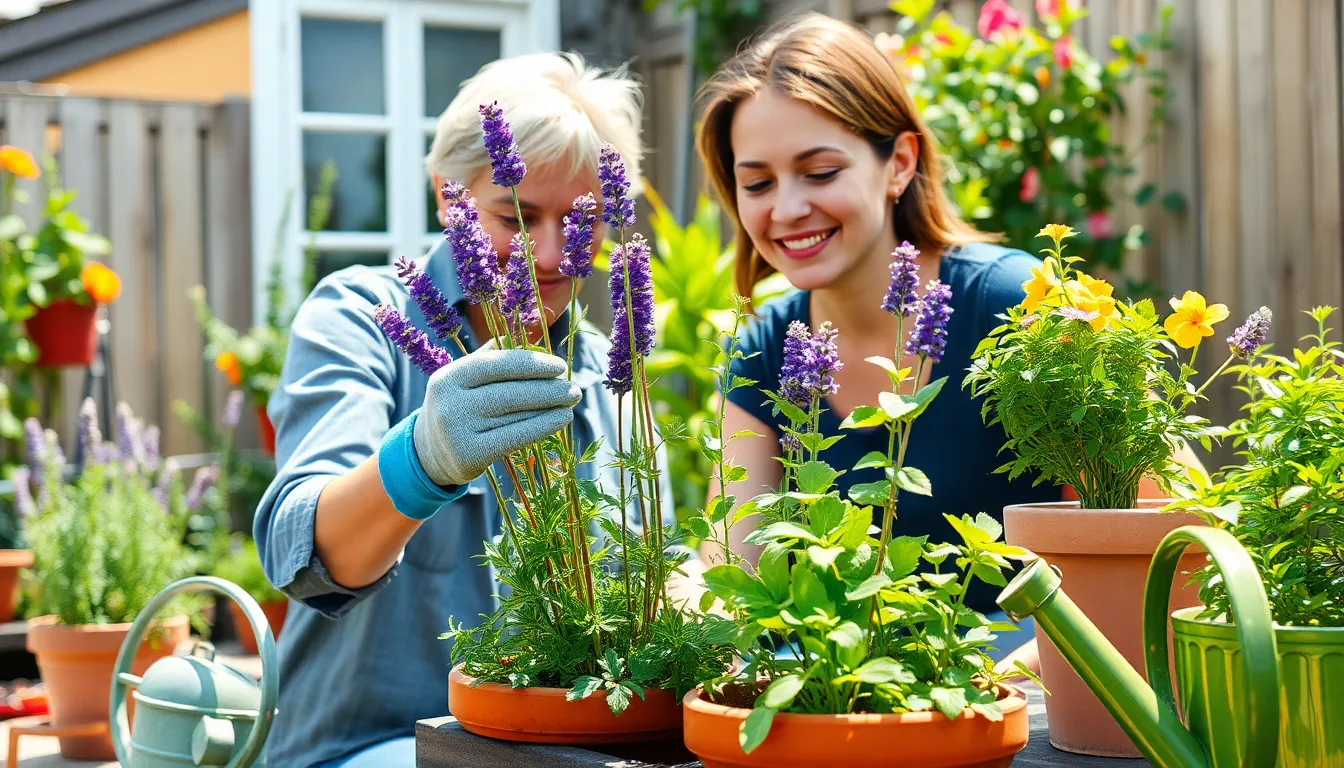
Even the most carefully planned mosquito repelling container gardens can encounter problems that affect plant health and pest deterring effectiveness. We’ll help you identify and resolve the most common issues to keep your natural mosquito defense thriving.
Address Overwatering Problems
Overwatering ranks as the leading cause of container plant failure and can actually attract mosquitoes through standing water. We recommend checking soil moisture by inserting your finger one inch deep into the potting mix before watering.
Drainage holes become essential for preventing root rot that weakens plants and reduces their natural repellent oils. We suggest adding extra drainage holes if water pools on the soil surface or takes more than a few hours to absorb.
Signs of overwatering include yellowing leaves, musty soil odors, and soft brown roots when you examine the plant. We advise reducing watering frequency immediately and improving drainage with perlite or coarse sand mixed into the potting soil.
Standing water in saucers creates mosquito breeding grounds that defeat your garden’s purpose. We empty plant saucers within 30 minutes of watering and elevate containers on pot feet to improve air circulation around drainage holes.
Manage Pest Infestations
Container grown mosquito repelling plants can attract aphids, spider mites, and whiteflies even though their natural pest deterrent properties. We inspect plants weekly for tiny insects, webbing, or sticky honeydew deposits that indicate pest problems.
Organic insecticidal soap provides effective treatment without harming beneficial insects or compromising the plants’ mosquito repelling qualities. We mix one tablespoon of mild liquid soap per quart of water and spray affected areas in early morning or evening.
Neem oil offers another natural solution that disrupts pest lifecycles while maintaining plant safety for outdoor living spaces. We apply neem oil treatments every 7 to 14 days until pest populations decline to manageable levels.
Beneficial insects like ladybugs and lacewings naturally control pest populations when we avoid harsh chemical treatments. We encourage these helpers by planting small flowering herbs like dill or fennel in nearby containers.
Handle Root Bound Plants
Root bound conditions occur when plants outgrow their containers and roots circle the pot’s interior walls. We check for this issue by gently removing plants from containers and examining root structure during spring repotting.
Circling roots appear as thick white or brown coils around the soil ball’s edges and indicate the need for immediate intervention. We carefully tease apart these roots with our fingers or make vertical cuts with a clean knife to encourage outward growth.
Container size upgrades solve most root bound problems while maintaining the mobility advantages of container gardening. We select new pots that measure 2 to 4 inches wider in diameter than the current container to provide adequate growing space.
Fresh potting mix becomes crucial when repotting root bound mosquito repelling plants since old soil loses nutrients and drainage capacity. We replace at least half the existing soil with high quality container mix designed for outdoor plantings.
Root pruning allows us to keep plants in their current containers when size limitations prevent upgrades. We trim away one third of the root mass and refresh the soil to stimulate new growth and restore plant vigor.
Conclusion
We’ve shown you how container gardening with mosquito-repelling plants transforms your outdoor space into a natural mosquito-free zone. By selecting the right containers sizing them properly and choosing effective plants like citronella lavender and marigolds you’ll create beautiful functional gardens that work harder than chemical alternatives.
Your success depends on strategic placement proper drainage and consistent maintenance. Remember to position containers near seating areas and entrances while combining different plants for maximum protection. With regular watering pruning and harvesting you’ll maintain healthy vigorous plants that keep mosquitoes at bay all season long.
Start small with a few containers and expand your mosquito-repelling garden as you gain confidence. You’ll discover that protecting your outdoor space naturally isn’t just effective—it’s rewarding and sustainable too.
Frequently Asked Questions
What are the best mosquito-repelling plants for container gardening?
The most effective mosquito-repelling plants for containers include citronella grass, lavender, marigolds, catnip, basil, rosemary, and lemongrass. These plants naturally produce essential oils and compounds that deter mosquitoes while adding beauty and fragrance to your outdoor space. Most thrive in containers and can be strategically placed around patios, doorways, and seating areas for maximum protection.
How deep should containers be for mosquito-repelling plants?
Most aromatic herbs like basil, rosemary, and lavender require containers at least 12 inches deep to accommodate their root systems properly. Larger plants like citronella grass need even deeper containers, typically 18-24 inches. Proper container depth ensures healthy root development, which directly impacts the plant’s ability to produce the essential oils that repel mosquitoes effectively.
Where should I place mosquito-repelling plant containers for best results?
Position containers close to outdoor seating areas to create a protective scent barrier. Place them around entry points like doorways and windows as a first line of defense. Create concentrated zones by arranging multiple containers together on patios. This strategic placement amplifies the plants’ natural deterrent effects and provides maximum protection where you spend the most time outdoors.
What type of soil should I use for container mosquito-repelling plants?
Use high-quality, well-draining potting mix specifically designed for container plants rather than garden soil. Garden soil can become waterlogged in containers, which attracts mosquitoes and harms plant roots. Add a drainage layer of gravel or pottery shards at the bottom, and ensure your containers have multiple drainage holes to prevent water accumulation.
How often should I water mosquito-repelling plants in containers?
Water according to each plant’s specific needs, checking soil moisture regularly by inserting your finger into the soil. Most mosquito-repelling plants prefer slightly dry conditions between waterings. Avoid overwatering, as stagnant water attracts mosquitoes and can cause root rot. Generally, water when the top inch of soil feels dry to the touch.
Can I combine different mosquito-repelling plants in the same area?
Yes, combining different repellent plants amplifies their effectiveness and extends coverage duration. Try pairing lemongrass with rosemary, or marigolds with lavender for both visual and aromatic benefits. Layer plants of different heights to improve scent diffusion, and position these combinations near seating areas to create concentrated protective zones that act as natural mosquito barriers.
How do I maintain mosquito-repelling plants for maximum effectiveness?
Regular pruning encourages new growth and increases essential oil production. Harvest leaves frequently to maintain plant vigor and release more aromatic compounds. Fertilize with balanced, organic options to support healthy growth. Crush leaves occasionally near seating areas to release concentrated oils. Monitor plants for pests and diseases, addressing issues promptly to maintain their pest-deterring properties.
What should I do if my container plants become root-bound?
Root-bound plants show stunted growth, water running straight through containers, or roots growing out of drainage holes. Repot into a larger container with fresh potting mix, or carefully prune roots if staying in the same pot. Root-bound plants lose their vigor and effectiveness at producing mosquito-repelling compounds, so addressing this issue promptly is crucial for maintaining protection.

